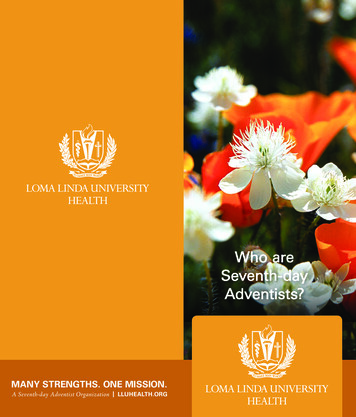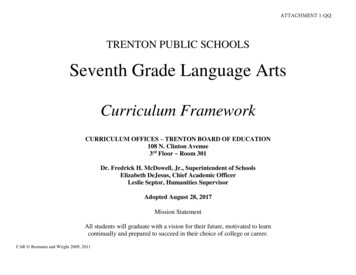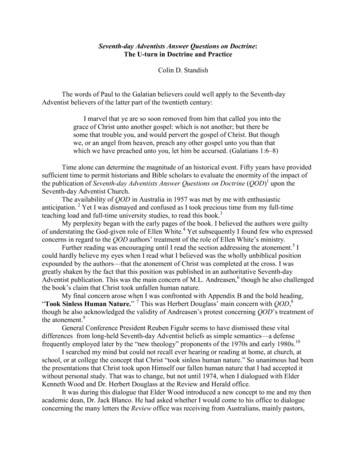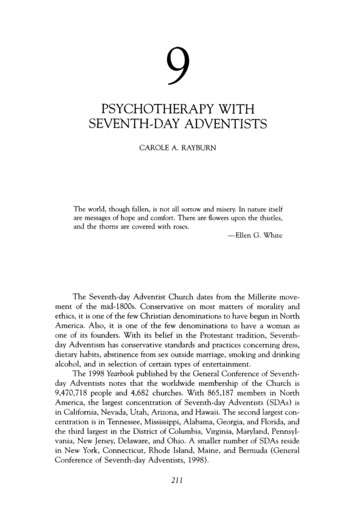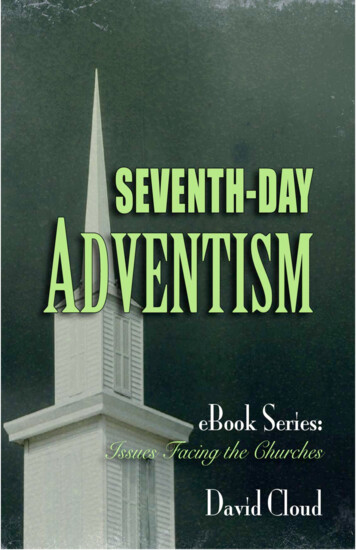
Transcription
1
Seventh-day AdventismCopyright 2008 by David W. CloudThis edition February 26 2013ISBN 978-1-58318-162-1This book is published for free distribution in eBook format. Itis available in PDF, MOBI (for Kindle, etc.), and ePUBformats from the Way of Life web site. We do not allowdistribution of this book from other web sites.Published by Way of Life LiteraturePO Box 610368, Port Huron, MI 48061866-295-4143 (toll free) - fbns@wayoflife.orgwww.wayoflife.orgCanada: Bethel Baptist Church4212 Campbell St. N., London Ont. N6P 1A6519-652-2619Printed in Canada byBethel Baptist Print Ministry2
Table of ContentsIntroduction .4The History .5The Doctrine.8Grace Plus Law .8Sabbath Keeping.15Soul-Sleep .19Annihilation of the Wicked .25Ellen White A Prophetess.27Investigative Judgment .32Misusing the Law of Moses .36Vegetarianism.40About Way of Life’s eBooks .44Powerful Publications for These Times.453
IntroductionThis report is excerpted from Avoiding the Snare of Seventhday Adventism. This book has been called the best on thesubject by the editor of The Baptist Challenge. It isresearched from official publications of the Seventh-dayAdventist organization and proves conclusively that theSeventh-day Adventist gospel is false. It is available in printand eBook editions from Way of Life Literature -www.wayoflife.orgThe Seventh-day Adventist denomination was established in1860 in America. “Seventh-day” refers to sabbath worship.“Adventist” refers to their belief that God raised them up toannounce the coming of the Lord. They have 15 millionmembers worldwide in 61,000 churches, and they areworking in 203 countries.4
The HistorySeventh-day Adventism originated with the Second Comingmovement of the 1800’s. William Miller, a Baptist preacher,concluded in 1818 that Christ would return to earth in 1843.When that was proven wrong, he changed the date toOctober 22, 1844. His belief was based largely on aninterpretation of Daniel chapters nine and twelve using theerroneous day/year equation (one prophetic day equals onehistorical year). Tens of thousands of people followed Miller,and many different groups sprang up within this excitedreligious atmosphere, all of them looking for the immediatereturn of Christ.After 1844, Miller quit setting dates and admitted hismistake, but some of his followers went on to form Seventhday Adventism.James White, Joseph Bates, and others began practicingsabbath-keeping in 1844 and published their views throughpamphlets.They also followed the visions of 17-year-old Ellen Harmon.She claimed that God showed her that in October 1844 Jesusentered the holy of holies in heaven to begin the“investigative judgment.” This is a foundational doctrine ofthe Adventist Church. Ellen taught that Jesus beganinvestigating the records of every person to determine whowould be saved and who would be lost. She also claimed toreceive a vision about the “Third Angel’s Message” inRevelation 14:9-12. She said that the mark of the beast (theantichrist) would be Sunday worship, and those whoworshipped on Sunday would be punished. She said that theones who keep the commandments of God refers to those5
who keep the sabbath in the last days. This is where theSeventh-day Adventists get their name. They claim to be thechurch of the last days that keeps the sabbath and thatprepares the way for Christ’s return.Ellen Harmon married James White in 1846 and theybecame the main leaders of Seventh-day Adventism.Between 1844 and 1915 Mrs. White supposedly received2,000 visions and dreams. Claiming that she wascommanded to write her visions for preservation, sheproduced over 100,000 handwritten manuscript pages.While Adventist leaders claim that the Bible is their sole rulefor faith and conduct, the fact is that without Ellen Whitethere would be no Seventh-day Adventism.We see, therefore, that the advent movement was unbiblicalfrom its beginning. It was led by a woman, which isforbidden in Scripture (1 Timothy 2:12), and it set a date forChrist’s return, which is also forbidden.“But of that day and hour knoweth no man, no, not theangels of heaven, but my Father only” (Mt. 24:36).“Watch therefore; for ye know not what hour your Lorddoth come” (Mt. 24:42).“Therefore be ye also ready: for in such an hour as yethink not the Son of man cometh” (Mt. 24:44).“Watch therefore, for ye know neither the day nor the hourwherein the Son of man cometh” (Mt. 25:13).“But of that day and that hour knoweth no man, no, not theangels which are in heaven, neither the Son, but theFather. Take ye heed, watch and pray: for ye know notwhen the time is” (Mk. 13:32-33).“It is not for you to know the time or the seasons, whichthe Father hath put in his own power” (Acts 1:7).6
By ignoring the plain teaching of the Bible about Christ’sreturn, the Adventists were led into more and more error.7
The DoctrineIn the following study we analyze some of the false Seventhday Adventist doctrines and compare them with Bible truth.Grace Plus LawSeventh-day Adventism professes to teach salvation by gracethrough faith, but they redefine this to add works to grace.According to Adventist doctrine, grace is the power andforgiveness God gives to enable a sinner to keep God’s lawand to thereby build a holy character fit for Heaven. Theindividual that fails to build the right character by God’sgrace will never see Heaven. Faith and works are said to bethe two oars by which the believer is propelled to glory.These false teachers are aptly described by the apostle Paulin his epistle to the Galatians: “And that because of falsebrethren unawares brought in, who came in privily to spy outour liberty which we have in Christ Jesus, that they mightbring us into bondage” (Gal. 2:4).It is important that we carefully document the Seventh-dayAdventist doctrine of salvation, since it is very subtle. Often,in their literature produced for the general public, theSeventh-day Adventists modify what they believe in anattempt to appear orthodox. The Christian should beware ofthe deceitfulness of the false churches. They are like thechameleon that changes colors according to varyingsituations. On one hand they try to appear orthodox. “We arejust like you,” they protest. On the other hand they promoteall sorts of heretical teachings and attempt to draw convertsaway from the Bible-believing churches. This should not8
surprise us. The New Testament refers frequently to thedeception of false teachers. Jesus called false teacherswolves in sheep’s clothing (Mat. 7:15). He warned that theywould try to deceive many (Mat. 24:4-5). The apostle Paulcalled them “deceitful workers” (2 Cor. 11:13). He said theyuse “cunning craftiness” (Eph. 4:14). He said they “speaklies in hypocrisy” (1 Tim. 4:2).Consider carefully the following statements about salvationfrom Adventist publications. While professing to believe insalvation by grace alone through faith alone, they redefinegrace. The result is a false gospel that mixes grace and law.From a Seventh-day Adventist Tract:“Christ says to every man in this world what He said to therich young ruler: ‘If thou wilt enter into life, keep thecommandments,’ Matthew 19:17. In other words, THESTANDARD FOR ADMISSION INTO HEAVEN IS ACHARACTER BUILT ACCORDING TO THE TENSPECIFICATIONS, OR COMMANDMENTS, OF GOD’SLAW. . THE MASTER BUILDER WILL STAND RIGHTWITH YOU AND IN YOU, AND SEE TO IT PERSONALLYTHAT YOUR LIFE COMES UP TO THE REQUIREMENTSOF GOD’S LAW” (Charles Everson, Saved by Grace, pp.45-46).From a Seventh-day Adventist Correspondence course:“Do you want to be a Christian? . The steps to Christ arefew and plain and easy to understand, and we will turn toGod’s Guidebook now for information. . Believe; that’sthe first step toward becoming a Christian. . the secondstep is repentance . repentance is simply being sorry forour sins and putting them away . the next step inbecoming a Christian is confession . real repentanceand confession mean not only to stop sinning, but to doeverything possible to make past wrongs right . The nextstep is baptism, and the proof for that is found in Acts2:38-39 . Fifth, obedience through Christ in us . Sowe have clearly outlined the steps that we need to take in9
order to become a Christian: to believe in God, to repentof and to confess our sins, to be baptized, AND TO OBEYALL THE COMMANDMENTS OF THE LORD. . He maystumble and fall, but he gets up and presses forwardagain, determined to overcome by God’s enabling power.Such a fall is not counted against him when he repentsand asks forgiveness and divine help to live the rightlife” (New Life Voice of Prophecy Guide, #12).Adventism labels this doctrine “salvation by grace,” but it isnot the grace that was preached by the Lord’s apostles.1. According to the Bible, salvation is by grace ALONEthrough faith ALONE, without the works of the law.“And if by grace, then is it no more of works: otherwisegrace is no more grace. But if it be of works, then is it nomore grace: otherwise work is no more work” (Romans11:6).See also John 3:16; 6:28-29; Acts 15:10-11; 16:30-31;Romans 3:19-25; 4:1-8; Galatians 3:10-13; Ephesians2:8-10; Titus 3:4-7.The Good News of Christ is not that we are saved through agrace that produces the works of the law. The Good News isthat we are saved by God’s grace alone through faith aloneWITHOUT THE LAW. All who will be saved must come onthese glorious terms, trusting in the shed blood alone for fullsalvation.Those who attempt to return to the Mosaic Law to perfecttheir salvation are committing the same error as the Galatiansin the first century.“O foolish Galatians, who hath bewitched you, that yeshould not obey the truth, before whose eyes Jesus Christhath been evidently set forth, crucified among you? This10
only would I learn of you, Received ye the Spirit by theworks of the law, or by the hearing of faith? Are ye sofoolish? having begun in the Spirit, are ye now madeperfect by the flesh? Have ye suffered so many things invain? if it be yet in vain. He therefore that ministereth toyou the Spirit, and worketh miracles among you, doeth heit by the works of the law, or by the hearing of faith? Evenas Abraham believed God, and it was accounted to him forrighteousness. Know ye therefore that they which are offaith, the same are the children of Abraham” (Gal. 3:1-7).Those who persist in placing themselves under the MosaicLaw in spite of clear New Testament teaching are outside oftrue salvation. Seventh-day Adventist teachers who believethe doctrine of their own denomination as stated in suchpublications as the New Life Voice of Prophecycorrespondence courses are of this number; they are Galatianlegalizers.“But now, after that ye have known God, or rather areknown of God, how turn ye again to the weak andbeggarly elements, whereunto ye desire again to be inbondage? Ye observe days, and months, and times, andyears. I am afraid of you, lest I have bestowed upon youlabour in vain” (Gal. 4:9-11).“My little children, of whom I travail in birth again untilChrist be formed in you, I desire to be present with younow, and to change my voice; for I stand in doubt ofyou” (Gal. 4:19-20).“Stand fast therefore in the liberty wherewith Christ hathmade us free, and be not entangled again in the yoke ofbondage. Behold, I Paul say unto you, that if ye becircumcised, Christ shall profit you nothing. For I testifyagain to every man that is circumcised, that he is a debtorto do the whole law. Christ is become of no effect untoyou, whosoever of you are justified by the law; ye arefallen from grace. For we through the Spirit wait for thehope of righteousness by faith” (Gal. 5:1-5).2. Salvation is secure.11
The true gospel says that the believer is saved entirely byGod’s grace through Christ and he has eternal life.We know that salvation is secure because it is a free gift,entirely unmerited by the sinner (Ephesians 2:8-9). If therecipient does anything or pays anything, the “gift” is nolonger a gift.We know that salvation is secure because it means that thebeliever is declared righteous by God (Romans 3:21-24).This is the meaning of the word “justified.” Notice how theterms “justified” and “the righteousness of God” are usedinterchangeably in Romans 3:21-24. Notice too, that thisrighteousness is obtained “by faith” and “freely by hisgrace.” What is the sinner’s problem? Is it not his lack ofrighteousness? Therefore, if God declares that sinnerrighteous, what more does he need? Biblical salvation is anexchange. Jesus takes the sinner’s unrighteousness, and thesinner receives Jesus’ righteousness (2 Corinthians 5:21).We know that salvation is secure because it is a presentpossession.In the following verses salvation is not described as apossibility, but as a certainty, as a present possession. Justification is a present possession (Rom. 5:9). Peace with God is a present possession (Rom. 5:1). Reconciliation is a present possession (Rom. 5:10). Atonement is a present possession (Rom. 5:11). Eternal life is a present possession (1 Jn. 5:11- 13). Being a child of God is a present possession (Eph. 1:6). Being accepted in Christ is a present possession (Eph. 1:6). Forgiveness of sin is a present possession (Eph. 1:7). Being made alive in Christ is a present possession (Eph. 2:1). Being made fit for heaven is a present possession (Col. 1:12 Being delivered from the power of darkness is a presentpossession (Col. 1:13).12
Having been translated into Jesus’ kingdom is a presentpossession (Col. 1:13). Mercy is a present possession (1 Pet. 2:10). Healing of sin is a present possession (1 Pet. 2:24).A person is either saved or he is lost, either entirely saved orentirely lost. There is no middle ground, no growing into orperfecting of salvation. Are you trusting the blood of Christ,and the blood of Christ ALONE for salvation? If so, theBible says you possess all the spiritual blessings listedabove, plus much more, and they are secure blessings inChrist!We know that salvation is secure because it is an entirely newposition before God.Salvation is an entirely new position in Christ (Romans5:1-2). The sinner is either in Adam or he is in Christ. If he isin Christ, he has all spiritual blessings. “Blessed be the Godand Father of our Lord Jesus Christ, who hath blessed uswith all spiritual blessings in heavenly places inChrist” (Eph. 1:3). See also Romans 6:11; Ephesians 1:6; 1John 5:12.The believer has a new standing before God in Christ, and healso has a walk in this world. The new standing cannotchange because it depends entirely upon what Jesus did forus on the cross. To confuse standing and walk is to pervertthe gospel. Consider the book of Ephesians. Chapters 1-3describe the believer’s new position in Christ; chapters 4-6describe the believer’s walk in this world. Ephesians 5:8says, “For ye were sometimes darkness, but NOW are yelight in the Lord: walk as children of light.” The believer hasa new position in Christ that can never change, and he iscalled to live up to this position in this world by walking in13
obedience to God. Colossians 3:1, 3 says the same thing: “Ifye then be risen with Christ, seek those things which areabove, where Christ sitteth on the right hand of God . Forye are dead, and your life is hid with Christ in God.” In hisnew position, the Christian is dead to sin and risen withChrist. In practice he is to live up to this eternal calling byseeking the things which are above.The believer’s new standing is eternally secure the momenthe is born again. His walk, on the other hand, changesaccording to his obedience.What a wonderful salvation! The better the believerunderstands his secure position in Christ, the more heartilyhe desires to serve his Savior God.We know that salvation is secure because the believer ispromised certain deliverance from sin.“Much more then, being now justified by his blood, weSHALL BE saved from wrath through him. For if, when wewere enemies, we were reconciled to God by the death ofhis Son, much more, being reconciled, we SHALL BEsaved by his life” (Rom. 5:9-10).We know that salvation is secure because the believer is keptby the power of God.“Blessed be the God and Father of our Lord Jesus Christ,which according to his abundant mercy hath begotten usagain unto a lively hope by the resurrection of JesusChrist from the dead, to an inheritance incorruptible, andundefiled, and that fadeth not away, reserved in heavenfor you, WHO ARE KEPT BY THE POWER OF GODthrough faith unto salvation ready to be revealed in thelast time” (1 Pet. 1:3-5).The believer can be sure that he will enjoy the inheritancespoken of in verse four solely because of the power of God.14
This does not mean that a person can live as he pleases andstill go to heaven just because he says he “believes.” TheLord Jesus Christ said that it is impossible to be savedwithout being born again (John 3:3, 7), and the new birth is adramatic, life-changing experience. “Therefore if any man bein Christ, he is a new creature: old things are passed away;behold, all things are become new” (2 Cor. 5:17). When asinner is born again, he receives a new nature from God. Hehas new desires. God’s nature within him impels him to liveGod’s way. The indwelling Holy Spirit ministers a desire forholiness and truth. The professor in Christ who does not loveGod’s way is not a saved man who falls away from salvation;he is a hypocrite or a deceived person who has neverpossessed true salvation.From the previous studies, it is evident that true Biblesalvation does not have the uncertainty and legalisticadmixture of the Adventist gospel. The SDA gospel is false.Sabbath KeepingSeventh-day Adventism says that the sabbath was given toAdam in the Garden of Eden and that God intended for allmen to keep it.“God instituted the Sabbath in Eden; and so long as thefact that He is our Creator continues to be a reason whywe should worship Him, so long the Sabbath will continueas its sign and memorial. . The keeping of the Sabbath isa sign of loyalty to the true God” (Ellen White, The GreatControversy, p. 386).Adventism says that Jesus and the apostles kept the sabbathand that it is binding upon all Christians.“. from this it is evident that all Ten Commandments arebinding in the Christian dispensation, and that Christ had15
no thought of changing any of them. One of thesecommands is the observance of the seventh day as theSabbath.” (Bible Footlights, p. 37).“The example of Jesus is clear and consistent. His customwas a Sabbath-keeping custom. . Yet in spite of this, wefind a strange situation in the world today. For though wehave the same Christ as our example, the same Bible asour guide, yet we find two Sabbath days kept byChristians.” (George Vandeman, Planet in Rebellion, p.277).They claim that Christians kept the sabbath until the fourthcentury when Constantine changed the law and forcedchurches to worship on Sunday.“Constantine was the Roman emperor. He was a sunworshiper, but he was also a keen politician. He wanted toplease everybody. It was while still a pagan that hedecreed that all government offices should be closed uponthe first day of the week—’the venerable day of the sun.’The church, which had now been established in Rome,had been quick to see the temporal advantage ofcompromise with paganism . so it was that after a fewbrief years, when Sunday had gained a foothold, theRoman church in the Council of Laodicea set aside theclear command of God and decreed the change from theseventh to the first day of the week” (Planet in Rebellion,p. 290).WHAT THE BIBLE SAYS1. The sabbath, though mentioned in Genesis 2:2-3, was notdelivered to man until it was given to Israel in the wilderness(Nehemiah 9:13-14). Ellen White added to Scripture whenshe taught that Adam and the patriarchs kept the sabbath.2. The sabbath was not given to mankind in general, but toIsrael alone as a special sign between her and God (Ex.31:13, 17). If the sabbath had been kept by mankind from the16
creation, it could not have been given as a special sign toIsrael.3. The New Testament teaches that the believer is not boundby the sabbath law. See Colossians 2:16-17.4. The sabbath was a type of salvation. “There remaineththerefore a rest to the people of God. For he that is enteredinto his rest, he also hath ceased from his own works, as Goddid from his” (Heb. 4:9-10). As God rested on the seventhday from His work of creation, the believer today rests in thecompleted work of Christ. In order to enter into God’s rest, aperson must accept God’s work and must cease from his ownwork (Jn. 6:28-29). Salvation must be accepted as God’s gift.5. Jesus kept the sabbath because He was born under the lawto fulfill the demands of the law. See Galatians 4:4-5. TheLord Jesus made Himself a servant and was born under thelaw of Moses that He might redeem sinners from the curse ofthe law and bring them into the eternal liberty of sonship.6. It cannot be proven that the apostle Paul and the earlychurches observed the sabbath. It is true that Paul met in thesynagogues on the sabbath in order to preach to the Jewsassembled there, but this does not mean that he observed thesabbath. According to the Bible, the reason Paul visitedsynagogues on the sabbath was to preach the gospel. Paul’sdesire was to preach Christ. He was burdened for his ownpeople, the Jews. So he went where the Jews were to preachChrist to them. Consider Acts 13:14-44; 16:13-14; 17:2-4;18:4.7. There is much evidence in the Bible and elsewhere that theearly Christians met and worshiped on the first day ratherthan on the sabbath.17
On the first day Jesus rose from the dead (Mk. 16:9).On the first day Jesus first appeared to his disciples (Mk.16:9).On the first day Jesus met with the disciples at differentplaces (Mk. 16:9-11; Mt. 28:8-10; Lk. 24:34; Mk. 16:12-13;Jn. 20:19-23).On the first day Jesus blessed the disciples (Jn. 20:19).On the first day Jesus imparted to the disciples the gift of theHoly Spirit (Jn. 20:22).On the first day Jesus commissioned the disciples to preachthe gospel (Jn. 20:21; with Mk. 16:9-15).On the first day Jesus ascended to Heaven, was seated at theright hand of the Father, and was made Head of all (Jn.20:17; Eph. 1:20).On the first day the gospel of the risen Christ was firstpreached (Lk. 24:34).On the first day Jesus explained the Scriptures to thedisciples (Lk. 24:27, 45).On the first day the Holy Spirit descended (Acts 2:1).Pentecost was on the 50th day after the sabbath following thewave offering (Le. 23:15-16). Thus, Pentecost was always ona Sunday.The Christians met to worship on the first day (Acts 20:6-7;1 Cor. 16:2).18
Since those days, the vast majority of Christians have met toworship on the first day of the week. They do this in honor ofthe resurrection of their Savior. Christ was in the tomb on thesabbath and rose as the firstborn from the dead on the firstday. The sabbath signifies the last day of the old creation(Gen. 2:2). Sunday is the first day of the new creation.8. Sunday is not the sabbath. Bible-believing Christians donot observe the sabbath by assembling on Sunday. The NewTestament believer is redeemed from the obligations of theLaw of Moses. Romans 14:1-13 and Colossians 2:16 clearlystate that believers are not to be judged in respect to holydays. The Galatians’ respect of holy days caused the apostlePaul to fear that they were not even saved! See Galatians4:10-11, 20.9. The idea that Sunday observance will be the mark of thebeast is not found in Scripture. This idea came from EllenWhite. It is true that the Antichrist will “think to changetimes and laws” (Daniel 7:25), yet nowhere does the Biblesay that this will involve the sabbath or Sunday. The Bibledoes not reveal exactly what laws the Antichrist will change.Soul-SleepThe Seventh-day Adventist Church teaches that those whodie do not go to heaven or to hell but their soul sleepsunconsciously in the grave until the resurrection.“To be dead does not mean to go to heaven; it does notmean to go to hell; it does not mean to go to purgatory.Indeed, it does not mean to go anywhere at all. It meanssimply an end of life. . Death is cessation of life, anabsence of life, the exact opposite of life. . The man doesnot live; the body does not live; the soul does not live; thespirit does not live; the mind does not live. Intelligence19
ends, consciousness ends, memory ends, knowledgeends, thought ends” (When A Man Dies, p. 20).Adventism teaches that the body and soul are not separateentities that can be parted at death.“.the soul of man nowhere is represented as a separate,conscious part of man existing as such when the bodysleeps in death. the soul of man comes with the breath; itgoes with the breath. . It has no function or power ofmanifestation or of action, no existence, apart from thebody.” (When A Man Dies, pp. 32, 33).They teach that the spirit is the breath.“. notice Job 27:3: ‘All the while my breath is in me, andthe spirit of God is in my nostrils.’ Again we find in themargin that spirit might also be translated ‘breath.’ The twowords are often used interchangeably in Scripture. . Nowlisten. ‘And breathed into his nostrils the breath of life; andman became a living soul.’ Nowhere are we told inScripture that God gave man a living soul. Man became aliving soul as the result of the union of the body with thebreath of life. . It is clear that the spirit that a manreceived from God and that goes back to God when hedies, is what God put into his nostrils. . when he dies, thetwo separate. The dust returns to the ground. The breath,or spark of life, from saint or sinner, returns to God whogave it. The living, loving, acting soul does not goanywhere. It simply ceases to be a conscious entity untilthe resurrection morning, when the body and the breath oflife are united again. That is Scripture pure andsimple!” (Planet in Rebellion, pp. 320-323).WHAT THE BIBLE SAYS1. The word “soul” has different meanings in Scripture.Sometimes it does refer to the whole man. Often, though, itrefers to a conscious, immaterial part of man that exists apartfrom the body beyond death. Words in the Bible must bedefined by the context in which they are found.20
Old Testament examples of the soul as an immaterial,conscious part of the man are seen in Genesis 35:18 and 1Kings 17:21-22. In Genesis 35 the death of Rachel isrecorded, and we are told that her soul departed when shedied. “. as her soul was in departing, (for she died).” In 1Kings 17 a young boy died and was raised again throughElijah’s ministry. The Bible plainly says that his souldeparted and then returned: “. O Lord my God, I pray thee,let this child’s soul come into him again. And the Lord heardthe voice of Elijah; and the soul of the child came into himagain, and he revived.” Obviously the prophet Elijah did nothave the same idea about the soul and death as the Adventistsdo.In the New Testament, the word “soul” is also used todescribe a spiritual part of man distinct from his body. “. Ipray God your whole spirit and soul and body be preservedblameless unto the coming of our Lord Jesus Christ (1 Th.5:23). Here we are told that man has three parts. Paul did notsay man IS a soul; he says man HAS a soul.2. The word “spirit” also has various meanings in Scripture.Just as the word “soul” does not always refer to the wholeman, but often refers to the immaterial part of man, even sothe word “spirit” does not always mean breath. Spirit oftenrefers to the conscious, immaterial part of man that is distinctfrom his body and that is separated from the body at death.This is the meaning in Genesis 45:26-27, where the spirit isused interchangeably with the heart. “And Jacob’s HEARTFAINTED, for he believed them not. And they told him allthe words of Joseph, which he had said unto them: and whenhe saw the wagons which Joseph had sent to carry him, THESPIRIT OF JACOB THEIR FATHER REVIVED.”21
Obviously, this passage does not refer to the spirit as thebreath! In Exodus 6:9, the children of Israel had “anguish ofspirit.” Was it their breath that was anguished! How silly.The word “spirit” obviously means something different inScripture than breath. Again, in Exodus 35:21, the Bibledescribes those who contributed toward the construction ofthe tabernacle as those “whose heart stirred him up, andevery one whom his spirit made willing.” Deuteronomy 2:30is another example of this. Here we find God hardening thespirit of King Sihon. In 1 Kings 21:5 King Ahab is said tohave had a “sad spirit.” Certainly none of these referencescould be construed as speaking of the spirit as the breath.The Seventh-day Adventist doctrine that the spirit is limitedto breath is contrary to the Bible’s own teaching.3. The New Testament plainly describes death as a departureof the spirit from the body. When we come to the NewTestament, any uncertainty remaining from our OldTestament studies disappears in the light of full revelation.One uniform doctrine of death is found throughout the NewTestament. Here death is plainly seen as a departure of thespirit from the body. Death means separation, not cessation.(This is how Adam and Eve could die the same day theypartook of the fruit. They died spiritually. They were “deadin trespasses and sins.” Later they died physically and thesoul was separated from the body.) This has been theorthodox doctrine of d
Seventh-day Adventist gospel is false. It is available in print and eBook editions from Way of Life Literature -- www.wayoflife.org _ The Seventh-day Adventist denomination was established in 1860 in America. “Seventh-day” refers to sabbath worship. “Adv
![Welcome [dashdiet.me]](/img/17/30-day-weight-loss-journal.jpg)
